Ushba
Svanetia
Watchtowers
Mountains
Maps
Svans
Art
Alpine trek
ON THE CLIFFS AND GLACIERS OF THE CAUCASUS
Photos: A. P. Sternberg
Text: B. L. Perlin, 1938
Translation: M. R. McConnell, 1999
Majestic and graced with extraordinary grandeur, the Caucasus range rises to a height of some 5 kilometers. The mountains of the Caucasus, sparkling with the whiteness of eternal snow and the azure play of flowing glaciers, jagged with wooded ravines, sing a siren's song to all those who yearn to roam the highlands freely.

¹1. View of the Caucasus range in the region of Adil-su.
Above and beyond all the other mountains and glaciers of the Caucasus range, rising to a height of 5600 meters above sea level, looms the huge snow-capped mass of the highest peak in the whole of Europe, Mt. Elbrus.

2. View of Elbrus from the river gorge Adil-su.
On their vacation days, tourists take to these woods, filled with the resinous aroma of stately pines and spruce trees, on the banks of alpine rivers and streams, climbing up to glaciers which cover the mountainous slopes.

3. 4. 5.
3.- In the Baksan river gorge
4.-The river Adil-su
5.-A group of Alpinists at the glacier Dolra
One of the most intriguing and popular routes to the Caucasus is the journey from Balkaria to Svanetia. An autobus hurtles tourists from Nalchik, the center of Karabardino-Balkarskii ASSR, for some 140 kilometers into the mountains, careening along through the Baksan gorge.
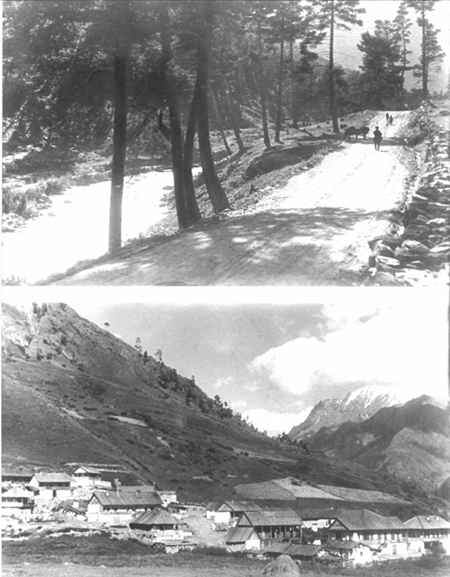
6. 7.
6.-Final kilometers of road from Nalchik to Elbrus.
7.-Balkarskii countryside
Koysuyurulgen (Red Elbrus)
Along the way they are met by the populace of the local countryside, which has changed quite a bit since the years of revolution. Where once leaned only the huts of old peasant villages (Aoul), now stand proudly the spacious colorful homes of the collective farms (Kolhoz).
The road ends. One can travel further only upwards, or by foot through the densely wooded undergrowth. In the past few years tens of fine bridges have been constructed throughout the canyons of the Balkarii river gorge.
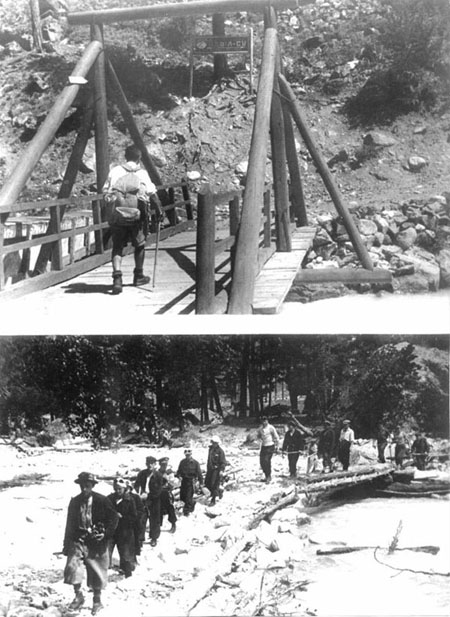
8. 9.
8.-Bridge across the river Adil-su built in 1937.
9.-Crossing over the upper reaches (headwaters} of the river Adil-su.
Now descending to a river and crossing over to the other shore, now jutting upwards to the cliffs studded with shoots of young verdure, now spanning mountain chasms, across which advance the travellers.
The day's journey is over. The first task of a tourist is setting up one's home, a tent. Once constructed, providing the means of a night's lodging, one can start making dinner. The next day, the hiking begins afresh.
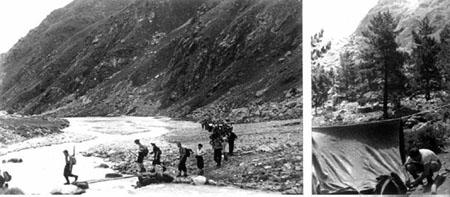
10. 11.
10.-The forest ends. Picturesque cliffs ring the gorge. Here a log of wood serves as a river crossing, uniting a bend in the river where the banks draw together.
11.-Towards evening the tourists reach the site of their last encampment before ascending the pass. This is one of the typical shelters which have been organized on the northern and southern ridges of the Caucasus range alongside most frequented scenic locations.
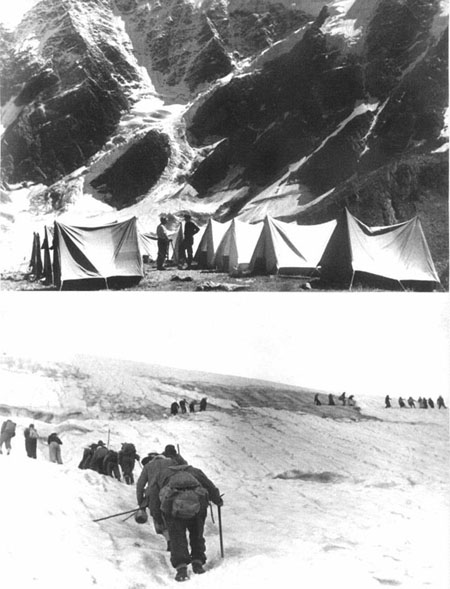
12. 13.
12.-Northern shelter under Dongul-Orun Pass.
13.-On Becho glacier
At first light the tourists pass through the last section of the mountain gorge along a barely visible path, and thence through morena [accumulation of fragments of mountainous rock, formed by the forward movement of glaciers] they approach the glacier.
Morning finds them already on the glacier.
The tourists walk through the mountain-pass.
Hidden to this point by the slopes of the canyon, the mountainous expanse of the Caucasus now extends before their eyes.
Below is a seen a glacier which has just begun to move, and further below, smoking in an azure haze, appears the wooded canyon.
Before them to the south, circuited by snow, lays the Svanetian mountain chain.
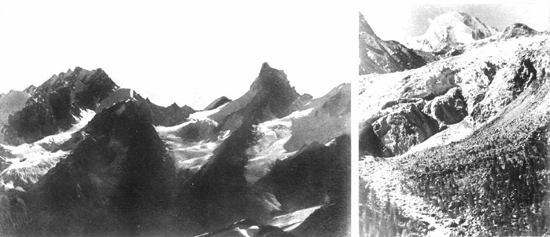
14. 15.
14.-The mountain ridge Ory-bashi. The summit of Tyu-tyu-bashi (left) and Dzhailik (right).
15.-The snowy summit of Bzhebux. On the forward plane the glacier Kashka-tash is visible.
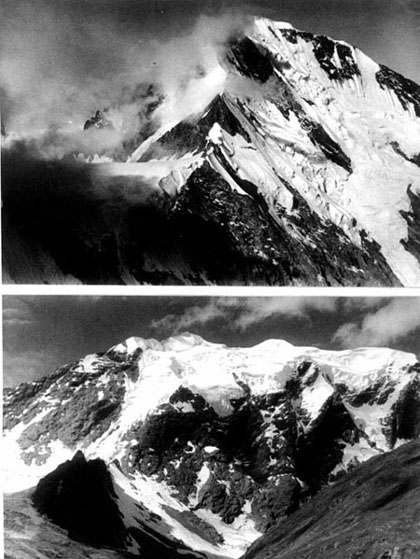
16. 17.
16-Struggling to rise above the clouds which threaten to obscure it, overlaid with snow-bound ledges, lurk the turret-like grey-black summits of Donguz-Orun.
17-Summit of Donguz-Orun-bashi, view from the glacier Becho.

18. 19.
18.-Descent from Becho Pass through the glacier Dolra.
19.-The Svanetian mountain chain from the Dolra gorge.
After a short rest at the pass - the descent below. Conditions change in reverse order: glaciers, cliffs, alpine meadows, woods, fast-flowing glaciers of the southern slope. Now are seen the thickly wooded mountain valley and the whole of lush Svanetia, a nature preserve jam-packed, teeming with life, bounded by the southern Svanetian range.
The trail soon leads to the banks of the raging river Dolra. Across it has been laid a light bridge without railings, which shakes with every step.
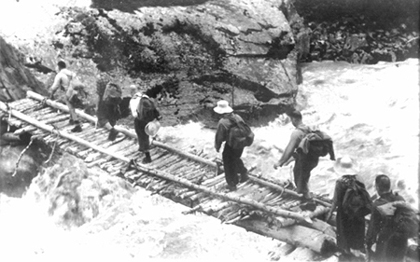
20. Fording across the river Dolra
In the course of the day the tourists descend into the hollow, down through the green cover of alpine meadows. Here are situated the tents of the southern shelter.

21. (Kotlovina) Canyon in the Dolra River Gorge.
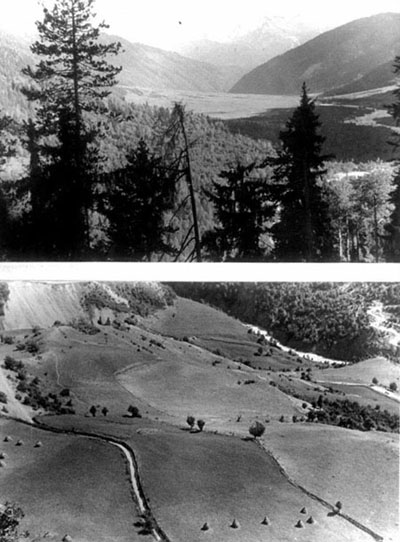
22. 23.
22.-Mazerskaya Hollow in Upper Svanetia.
23.-Mountain pasture in Svanetia.
After 2-3 days of travel about Svanetia, by way of her wooded slopes and meadows, the tourists reach the center of Upper Svanetia - Mestia - where their mountain journey draws to a close.
In Mestia the tourists rest for a few days at the "Home of the Tourist." After their rest, part of the tourists are dispatched by plane or autobus to the shores of the Black Sea, while others are returned to Balkaria.
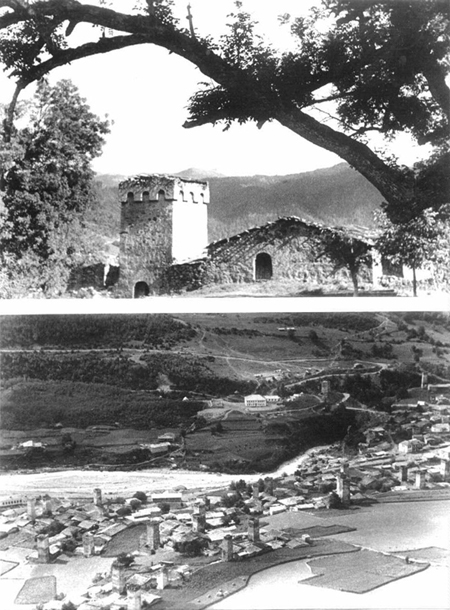
24. 25.
24.-Old church in the Svan village of Lamalz.
25.-Center of Uper Svanetia. Town of Mestia.
Taking a hike in the mountains is the first step towards a most remarkable sport - alpinism (alpineering). Not by accident does alpinism attract our young. The ascent of snowy summits and the overcoming of glaciers toughens the human organism, demands deciseness and caution, boldness and cold-blooded cool (composure), which in turn cultivate the will, fostering cameraderie and collective support.
26. Follow the Alpine Leader.
Alpinism is beset by huge difficulties. One must surmount the steepest of grades, using little more than a rope,while climbing straight up sheer cliffs, making one's way up through treacherously slippery slopes. One has to struggle with the dangers of the mountain: with rockslides, avalanches, storms and fog, which completely without warning envelop the climbers and obscure everything all around, depriving alpinists of any chance to orient themselves to the surrounding chaos.
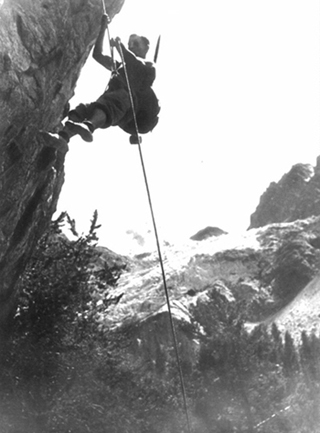
27. Two hooks are better than one.
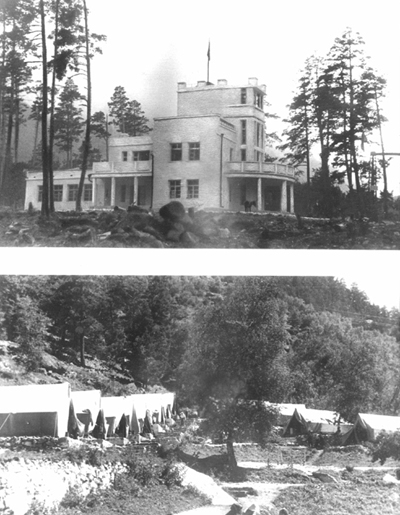
28. 29.
28.-The Worker-Peasant Red Army Alpine School in the region of Elbrus.
29.-All-Union Central Professional Sports Club Alpinist camp in Adil-su.
In capitalist countries alpinism is inaccessible to workers. In the USSR conditions have been created for the broad development of alpinism and mountain camps, where young alpinists go through special training under the watchful eyes of experienced instructors. Already there number greater than 10,000 alpinists, bearing the insignia, "Alpinist USSR", and hundreds of qualified instructors, masters of alpinism.
30. 31. 32. Instructor leads the group in the fine art of mountain climbing.
Young alpinists are dispatched for practical training. The instructor acquaints them with basic techniques of climbing and safety procedures on the cliffs. He checks their rope-winding skills and verifies their ability to tie various knots and splices.

33. 34. 35. Ascent of a steeply-inclined cliff.
Komsomolka Vera Perederye for the first time completes an ascent of a steeply inclined
cliff. She still hasn't entirely mastered the technique, but remembers to abide by the
golden rule of alpineering: always maintain 3 points of support, choosing attentively
finger and toeholds (hook, peg, hitch, cast, snag) for both hands and feet.
The ascent is successful; she overcomes a nearly vertical slope. She thus, in a secure position, is able to act in the capacity of protector. Having fortified herself in a stable position against the rocks, she insures the safety of the next comrade who follows after her with a climbing rope.
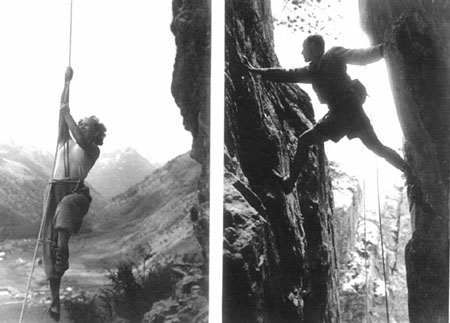
36.
37.
Springtime for Alpinists
36.-There, where the cliff overhangs the very cornices (ledges), you have to know how
to climb up with the aid of a slip of rope they call a "Prusik" noose.
37.- An instructor demonstrates the technique of scaling a chimney.
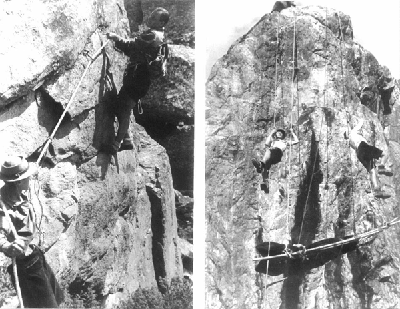
38. 39.
By Hook or by Crook
38.- Scaling round-the-bend.
39.- Lowering a fallen dummy comrade.
Instructors demonstrate methods of scaling technique used in extraordinary situations during ascent of especial difficulty. One of these methods - "Zailtsut" - is climbing up a sheer cliff wall with the help of scaling hooks and rope. Instructors demonstrate methods of life-saving in the mountains using "underhanded" means: ropes and mountain climbing rods designed for lowering the injured.
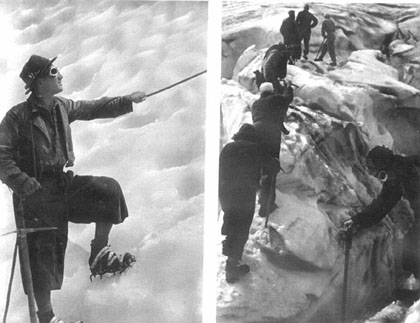
40. Blinding glare - dark glasses. 41. Peg with icepick - crevasses.
While one group trains on the cliffs, another is put through the paces of walking on glaciers, adapting their technique of movement to the terrain, paying particular attention to methods of self-protection. Here the basic means of armament employed are known as "cats", climbing irons (grappling) which prevent slippage on the glacerious inclines. Eyes are protected from the blinding glare of snow by dark glasses.
Alpinists learn to choose the most practical path amidst a labyrinth of trenches, rifts and shortfalls, capering about the trenches with light jumps, wielding an icepick.
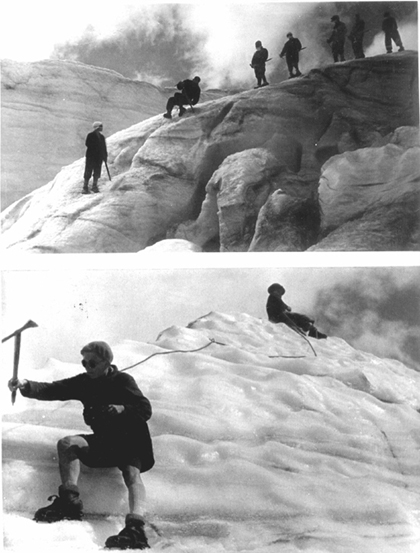
42. 43.
42.-During descent of a glacier slope an icepick serves as additional grip.
43.-On the more sharply inclined slopes a rope is used for mutual safety. An icepick is
also used for chopping steps where the steepness of the slopes rules out the practical
usage of spiked 'cats'.

44. 45. 46.
44.-Political discussion group in Alpinist Camp "Front Company".
In the camps of the Alpinists, massive political and cultural work is carried out: a
"wall-paper" is published, daily meetings are held where there is a collective
reading of the journal. Additionally, alpinists are read lectures on the history of
mountain-climbing, the structure of mountains, and the key role nutrition plays in fueling
mountain-expeditions.
45.-A book is the constant companion ("sputnik") of the alpinist in his free
hours.
46.-The sun goes down. The mountains plunge swiftly into the impenetrable darkness of
night. In the gloom of night flames flicker on the slopes of the mountain gorge. In their
camps the Alpinists are illumined as traditional evening campfires begin to blaze. Far
along the canyon walls, the ringing song of youth resounds.
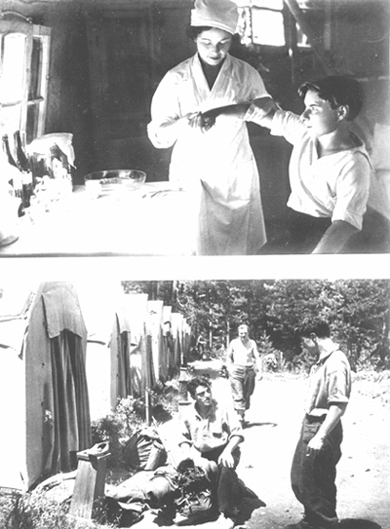
47. Alpine medical check-up.
48. Packing essentials for the test-climb.
After two weeks of practice training, the test-climb to the top awaits. Before this
sort of exam there must be thorough preparation.
All participants in the forthcoming ascent are examined by the camp doctor. Relevant
equipment is checked out and adjusted. Supplies of provisions and warm clothing are
methodically packed in a rucksack. Setting off for the mountains, one learns to take
everything necessary and nothing more.
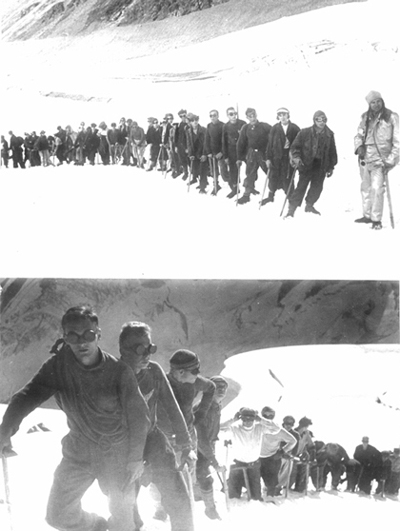
49. 50.
49.-On the glacier Dzhankyat.
50.-On the snowbound plateau of Dzhantygan
A detachment of alpinists from camp Adil-su sets out in a column across the glacier Dzhankyat and at the end of the day arrives at the snowbound plateau of Dhzantygan.
Rising with the early morn, after passing the night on the plateau, the detachment begins its assault on the summit.
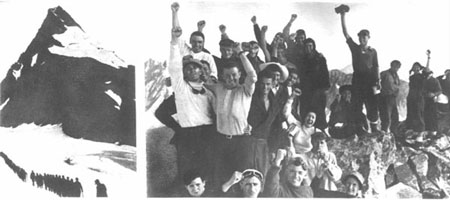
51.
52.
51.-In the morning to the mountain.
52.-In the evening to the fountain.
The summit of Dzhantygan (height 4218m.).
After several hours of stubborn climbing, through effort of sheer will and persistence, all of the alpinists reach the summit. Yet another detachment of Soviet youth has won the right to bear the coveted insignia mark "ALPINIST USSR".
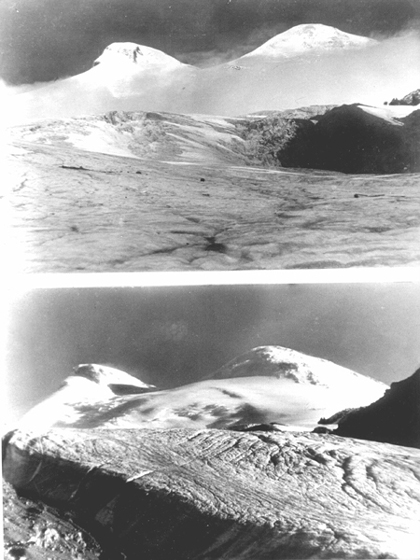
53. & 54. Two views of Mt. Elbrus.
Alpinists of camp "Front Company" complete their first test climb on Mt.
Elbrus. Until 1914 Elbrus had been conquered roughly 20 times. Since the October
revolution Soviet Alpinism has carried on massive campaigns to ascend Elbrus. In 1935 more
than 2000 people visited its summit. Elbrus - the highest mountain in Europe - has been
turned into a training summit for Soviet Alpinists.
The Alpinists spend their first night's lodging at "Krygogore", height 3200m.
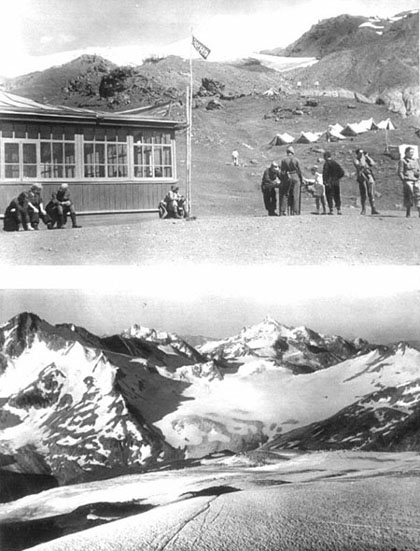
55. 56.
55-Mountain hotel "Krygogor" on the south-eastern slope of Elbrus.
56-View from the glacier Maliy Azay - the summit of Shtavler, Kyarmash, and the glacier
church of Djeiper-Azay.
The following day begins the ascent of Maliy Azay (little Asia) and the snow-pressed fields of Elbrus. The higher one climbs, the more majestic the view; the imposing grandeur of the main Caucasus range is quickly revealed in a startling succession of increasingly panoramic views.
At the last site of morena (glaciated, pulverized remnants of boulders) before "Shelter 11", the entire central part of the Caucasus mountain range comes into view: the summit of beautiful Ushba, the peak Shxeldi, the Ushba glacier plateau, Chatin-tay, the peak Shurovskovo.

57. 58.
57.-Summit of Ushba, Shxeldi, Chatin-tay
58.-Soviet Alpinists steadfastly pursue their objective, "Shelter 11".
The Alpinists have reached "Shelter 11". They spend they a final night's lodging in a tourist hut on the cliff-edge of the shelter grounds, surrounded by eternal snow, prior to launching their final assault on the summit of Elbrus.
In the dead of night the Alpinists advance by moonlight towards Elbrus.
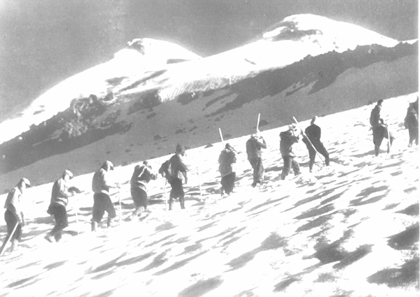
59. At night all cats are grey.
In the morning there they all were, on top of the eastern peak, height 5600m.
Soviet sportsmen year in and year out set new world records in an all aspects of sports. Soviet Masters of Alpinism have also set before them the task of vaulting onto the world stage and achieving international recognition. Already they have scaled to the loftiest heights of the SSSR - the Peak of Stalin, the peak of Lenin, and the summit of Xan-Tengri.
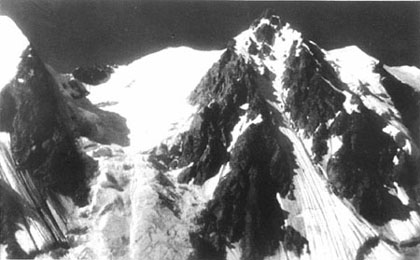
60. The summit of Shxara.
In 1932 Soviet Alpinists first completed a traverse of the highest part of the central Caucasus - the Bezungiskii Wall (the summit of Shhara - 5184m., Dzhangi-tay - 5051m, Katin-tay - 4968, Gestola - 4680m).
The first Soviet expedition successfully ascending the peaks of Ushba was completed in 1934. In 1936 and 1937 already a series of ascents of the southern and northern peaks and several traverses in-between have been completed.

61. To the Caucasus was Prometheus bound.
Man proposes, God disposes, Mt. Ushba imposes
In 1935 Soviet Alpinists for the first time ascended one of the most difficult summits in the Caucasus, Shxeldi. In 1936 and 1937 the ascent on Shxeldi was completed 3 times.
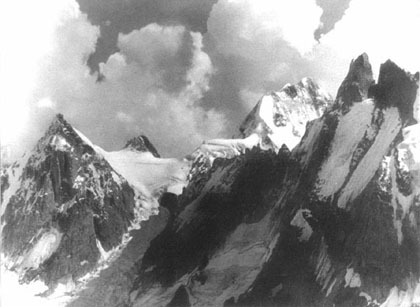
62. The black cone of Shxeldi
Soviet Alpinism has become a most remarkable proving ground for testing the limits of individual courage and the ultimate strength of collective endeavors. Steeled by mountain campaigns, courageously overcoming everpresent hardships and dangers, Soviet Alpinists stand at the ready, vigilantly protecting its mountain frontiers in defense of its socialist motherland.